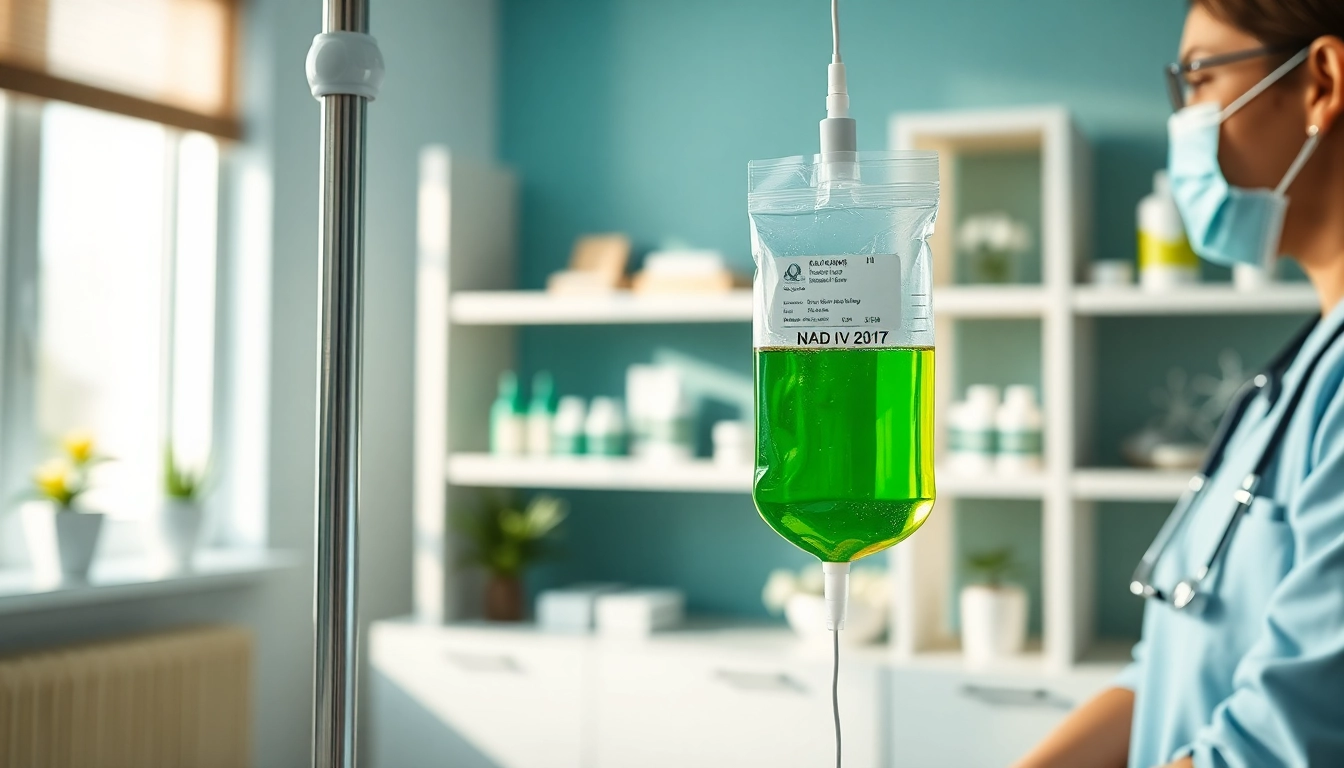What is NAD IV Therapy?
Definition and Overview of NAD IV Therapy
NAD IV therapy involves the administration of nicotinamide adenine dinucleotide (NAD+), a vital coenzyme found in every cell of the body, via intravenous infusion. This method allows for rapid absorption and utilization of NAD+, thus maximizing its benefits in the body’s cellular processes. NAD+ plays a crucial role in energy production, DNA repair, and cellular metabolism, making it instrumental in maintaining optimal health and wellness.
Health Benefits of NAD IV Therapy
The health benefits of NAD IV therapy are vast and varied, appealing to those seeking a range of wellness improvements. Key advantages include:
- Increased Energy Levels: NAD+ supports the production of ATP (adenosine triphosphate), the energy currency of cells, which can lead to significantly higher energy levels and reduced fatigue.
- Enhanced Cognitive Function: NAD+ has been shown to improve brain function, alertness, and focus by promoting cellular health within the brain.
- Anti-Aging Properties: NAD+ assists in repairing damaged DNA and preventing cellular aging, positioning it as a key player in anti-aging therapies.
- Mood Improvement: Many users report enhanced mood and decreased anxiety levels, likely due to NAD’s roles in neurotransmitter regulation and overall neuronal health.
- Detoxification Support: NAD IV therapy can support the body’s detoxification processes, particularly in individuals recovering from substance abuse or excessive alcohol consumption.
Who Can Benefit from NAD IV Therapy?
Various populations may benefit from NAD IV therapy, including:
- Athletes: For athletes, NAD+ can aid in performance enhancement and recovery by improving endurance and reducing exercise-related fatigue.
- Individuals Experiencing Chronic Fatigue: Those suffering from chronic fatigue syndromes or general fatigue may find rejuvenation and increased vitality through the therapy.
- Older Adults: Seniors focusing on anti-aging and longevity treatments often seek NAD IV therapy for its potential to enhance cellular repair processes.
- Patients in Addiction Recovery: Recovery from substance abuse often leads to low energy and cognitive challenges that NAD therapy may help alleviate.
- Those Undergoing Stressful Circumstances: Individuals experiencing high stress, either mentally or physically, may benefit from the restorative effects of NAD.
NAD IV Therapy Cost Breakdown
Typical Pricing Tiers for NAD IV Therapy
The cost of NAD IV therapy can significantly vary across clinics and geographical locations. Generally, patients find that:
- Single NAD infusion sessions can range from approximately nad iv therapy cost of $200 to $1,500.
- Some clinics offer initial lower doses at around $250, increasing based on the amount of NAD+ administered.
Packages that include multiple sessions often present a discount, resulting in savings for those committed to ongoing treatments.
Factors Influencing NAD IV Therapy Cost
Several factors play a role in determining the specific costs associated with NAD IV therapy:
- Dosage: Higher doses of NAD+ generally lead to higher treatment costs.
- Clinic Location: Urban clinics may charge more than rural clinics due to higher operational costs.
- Clinic Reputation: Well-established clinics with experienced providers may come at a premium.
- Inclusion of Additional Treatments: Some patients may choose to combine NAD with other therapies or injections, driving costs higher.
Comparing Costs: Single Session vs. Packages
Comparing the value of single sessions versus packages is critical for budget-conscious clients:
Single sessions are ideal for newcomers wishing to test the benefits of NAD therapy without a long-term commitment, often starting from $200 depending on provider specifics.
In contrast, purchasing package deals—typically consisting of five to ten sessions—can reduce the average cost per session. Examples include:
- Three-session packages averaging $500 might reduce costs to about $170 per session.
- Some establishments offer full treatment programs where patients can experience a series of appointments at a significantly lower cumulative rate.
Regional Variations in NAD IV Therapy Cost
National Average Cost Insights
On a national scale, NAD IV therapy costs exhibit considerable variation. While major metropolitan areas may see prices peaking at $1,500 for premium services, rural areas often present more affordable options, sometimes as low as $200 per session.
Overall, the average per-session cost tends to hover between $500 to $2,000 for most clinics across the USA based on regional health trends, clinic competition, and local demand.
State-by-State Cost Differences
State regulations, market saturation, and local health trends can noticeably affect prices. For instance:
- States with a higher cost of living, such as California and New York, often command higher prices.
- Conversely, prices in states with lower overall medical expenses, like Arkansas or Mississippi, tend to be less steep.
Additionally, individual state healthcare regulations and licensing require separate considerations which can affect accessibility and overall treatment costs.
Local Clinics and Pricing Strategies
Local clinics often develop creative pricing strategies to attract clients, including:
- Membership Programs: Patients may join wellness programs allowing discounted rates for repeated treatments.
- Referral Discounts: Incentives may be offered towards both new clients and those referring individuals.
- Seasonal Promotions: Some clinics offer promotional rates during certain times, which can lead to limited-time savings.
By leveraging different pricing strategies, clinics can enhance affordability for their services while fostering a loyal patient base.
Insurance Coverage and Financing Options
Understanding Your Coverage for NAD IV Therapy
A key consideration for many potential recipients of NAD IV therapy is whether their health insurance will cover the cost. Unfortunately, most insurance policies do not typically cover NAD therapy as it is often classified as an elective or alternative treatment. Patients must consult with their insurance provider to clarify coverage options.
Available Financing Options for Patients
Given the potential costs involved, many clinics offer financing options to assist patients. Some common financing methods include:
- Payment Plans: Clinics may allow patients to pay for their treatments over time rather than requiring full payment upfront.
- Healthcare Credit Cards: Specialized financing through healthcare credit cards can help patients manage treatment costs with low or no interest.
- Personal Loans: Some patients opt for personal loans to cover healthcare expenses, potentially offering more flexibility in repayment.
Negotiating Costs with Providers
When considering NAD IV therapy, being open to negotiation can lead to reduced costs. Patients may ask about:
- Discounts for upfront payments.
- Possibility of reduced pricing if they commit to multi-session packages.
- Group discounts if friends or family also wish to pursue treatment.
Being informed and proactive about potential costs can aid in securing the best rates available.
Future Trends in NAD IV Therapy Cost
Predicted Changes in Pricing Over the Next Few Years
As the popularity of NAD IV therapy continues to grow, market forces may significantly influence pricing trends. Should demand consistently rise, clinics may increase prices. Conversely, as more clinics enter the market, competitive pricing could lead to overall reductions.
Impact of Technological Advancements on Cost
Technological advancements in healthcare often translate to efficiencies that could lower costs. Innovations in treatment protocols or delivery methods may streamline operations and potentially reduce costs passed onto the patients.
Consumer Demand and Its Effect on NAD IV Therapy Cost
The increasing consumer demand for alternative health treatments suggests that as more individuals seek out NAD IV therapy, prices could fluctuate based on availability and clinic responses to this demand. Therefore, remaining informed about market dynamics is critical for patients seeking treatment.



